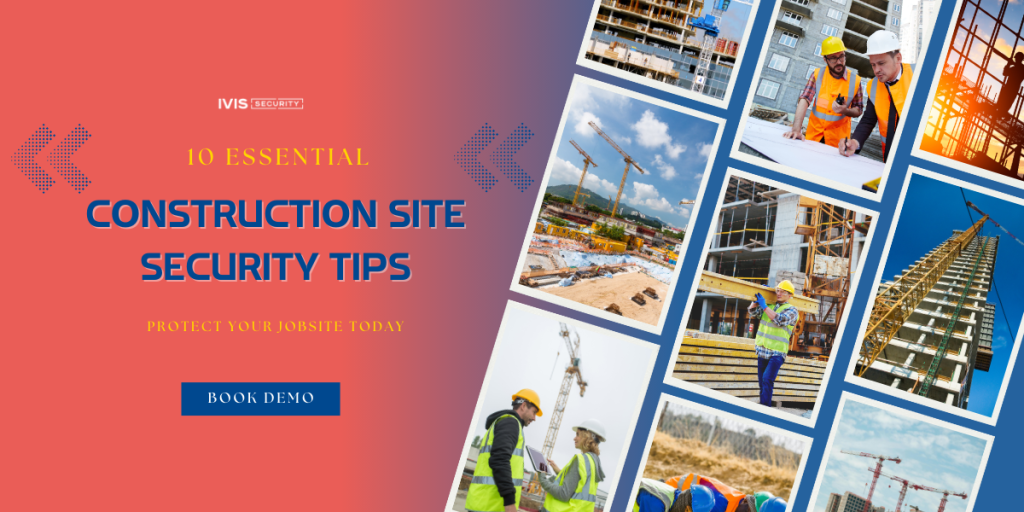10 Essential Construction Site Security Tips
Every construction site carries serious risks: costly machinery left unsecured, building materials left exposed, and strict deadlines that demand everything stays on track. Unfortunately, jobsites are also prime targets for theft, vandalism, and trespassing. Without a proactive construction site security plan, these risks can quickly turn into financial losses, liability claims, and costly downtime.
Here are ten proven strategies that leading contractors and site owners rely on to keep their projects secure.
1. Deploy Advanced Surveillance Systems
A strong construction site surveillance system is your first line of defense. Visible cameras deter unauthorized access while providing a digital record of all activity.
2. Implement 24/7 Camera Security
Today’s construction site camera security offers high-definition visibility, motion-triggered alerts, and cloud storage—ensuring continuous coverage of your assets day and night.
3. Establish Perimeter Protection
Secure fencing, locked gates, and intrusion signage reduce exposure and channel all traffic through monitored access points.
4. Construction Site Video Surveillance
Cameras alone can’t intervene. With construction site security monitoring, trained professionals continuously monitor your feeds in real-time and respond instantly to any suspicious activity.
5. Control Site Access
Issue access badges, track entries with log systems, and restrict visitors to designated checkpoints. Controlled access limits both theft and liability.
6. Safeguard High-Value Assets
Lock down heavy machinery, store tools securely, and leverage GPS tracking where possible. Target-hardening equipment reduces your risk of loss.
7. Enhance Lighting for Deterrence
Well-lit areas eliminate blind spots. Motion-activated lighting creates both a visual deterrent and an immediate alert to possible intrusions.
8. Formalize Security Policies
Security should be part of your safety culture. Document protocols for workers and subcontractors, and train staff to report suspicious behavior.
9. Monitor Critical Zones
Fuel tanks, electrical systems, and material storage areas are high-risk targets. Dedicated construction site video surveillance ensures these vulnerable zones are under constant watch.
10. Partner with a Professional Security Provider
Quick fixes can’t handle today’s threats. A security partner provides you with complete protection to prevent problems before they arise.
At IVISecurity, we understand the unique risks construction sites face. Our solutions combine advanced construction site surveillance, intelligent construction site camera security and 24/7 construction site security monitoring to deliver unmatched protection. With live operators ready to trigger deterrents—sirens, alerts, and rapid response protocols—we stop intrusions before they escalate.
Our comprehensive construction site video surveillance systems are designed to safeguard equipment, protect crews, and keep projects on schedule. When you partner with IVIS Security, you’re not just installing cameras—you’re investing in a proactive security strategy that reduces risk, prevents downtime, and protects your bottom line.
Book your demo. Protect your jobsite today. Trust IVISecurity.
FAQs on Jobsite & Construction Site Security
1.What is a jobsite security camera trailer?
A jobsite security camera trailer is a portable, solar-powered unit that provides 24/7 surveillance for construction and outdoor sites. It’s an ideal solution for projects that need flexible and reliable mobile security cameras.
2.How do mobile security cameras work for construction sites?
Mobile security cameras for construction sites provide flexibility by allowing cameras to be moved as the site develops. These cameras often come with solar power, wireless connectivity, and remote monitoring, making them ideal for changing jobsite layouts.
3. What are the benefits of mobile security cameras compared to fixed systems?
Mobile security cameras are easier to install, relocate, and manage compared to fixed systems. They’re especially useful for construction and outdoor projects where the site changes frequently, ensuring continuous surveillance without additional installation costs.

